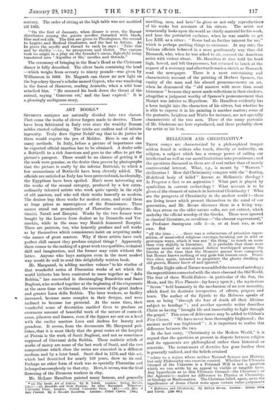ART BOOKS.* Srtnuous antiques are naturally divided into two classes.
First come the works of clever forgers made to deceive. These have been fabricated in Italy ever since the wealthy Roman nobles started collecting. The tricks are endless and of infinite ingenuity. Truly does Signor Nobilit say that to do justice to them would require the pen of Moliere. Here is one of the many methods. In Italy, before a picture of importance can be exported official Sanction has to be obtained. A dealer sells a Botticelli to a rich American and goes to the office to get the picture's passport. There would be no chance of getting it if the work were genuine, so the dealer then proves by photographs that the picture is really by the inferior Botticini, to which a few mannerisms of Botticelli have been cleverly added. The officials are satisfied as Italy has been protected and, incidentally, the Egyptians have been spoiled. Much more interesting are the works of the second category, produced by a few extra- ordinarily talented artists who work quite openly in the style of old masters, and who sell their works honestly as modern. The dealers buy these works for modest sums, and retail them at huge prices as masterpieces of the Renaissance. Three names stand out prominently of Florentine sculptors—Bas- tianini, Natali and Zampini. Works by the two former were bought by the Louvre from dealers as by Donatello and Ver- rocehio, while in the same way Munich honoured Zampini. There are painters, too, who honestly produce and sell works as by themselves which connoisseurs insist on acquiring under -the names of great masters. Why if these artists have such perfect skill cannot they produce original things ? Apparently there comes to the making of a great work two qualities, technical skill and imagination, and the former may exist without the latter. Anyone who buys antiques even in the most modest way would do well to read this delightfully written book.
Mr. Marquand, in adding another volume' to his studies of that wonderful series of Florentine works of art which the world hitherto has been contented to mass together as "della Robbie," has succeeded in disentangling Benedetto and Santi Buglioni, who worked together at the beginning of the cinquecento at the same time as Giovanni, the successor of the great Andrea and greater Luca della Robbie. The later workers, as facility increased, became more complex in their designs, and were inclined to become too pictorial. At the same time, their wonderful sense of decoration enabled them to produce an enormous amount of beautiful work of the nature of coats-of- arms, pilasters and frames, even if the figures are not on a level with the earlier masters Luca and Andrea for beauty and grandeur. It seems, from the documents Mr. Marquand pub- lishes, that it is most likely that the great series at the hospital at Pistoia is the work of Santi Buglioni, and not as sometimes supposed of Giovanni della Robbia. These realistic reliefs of works of mercy are some of the last work of Santi, and the two compositions which close the series are executed in a different medium and by a later hand. Santi died in 1576, and this art., which had flourished for nearly 150 years, drew to its end. Perhaps no other form of work was so specially Florentine and belonged so completely to that city. Here, it seems, was the final flowering of the Etruscan workers in clay.
Mr. MeLure Hamilton painted many famous, and generally
• (1) Tha Gentle Art of Faking. By R. Nobill. London: Seeley, Service. L21s.]—(2) Benedetto and Santi Buglioni. By Allan Marquand. Princeton • University Tress; London: Oxford University Press. 143.)—(3) Men I have Painted. By J. AtcLura kiaminka. Landon: Fisher Unwin. [30e.J unwilling, men, and here' he gives us not only reproductions of his works but accounts of his sitters. The artist not unnaturally looks upon the world as chiefly material for his work, and here the portraitist exclaims, when he was unable to get Leo XIII. as a sitter : " Rome had no further interest for me," which is perhaps pushing things to extremes. At any rate, the Vatican officials behaved in a more gentlemanly way than did Bismarck, who, when he was asked to sit, covered the American artist with violent abuse. Mr. Hamilton at first held his head high, bowed, and left the presence, but returned to lunch at the request of a secretary and afterwards made a sketch as Bismarck read the newspaper. There is a most entertaining and characteristic account of the painting of Herbert Spencer, the vanity of the man and his absurd pronouncements on art, when he denounced the " old masters with more than usual bitterness " because they never made reflections in their shadows, altogether a judgment worthy of Spencer's pronouncement that Mozart was inferior to Meyerbeer. Mr. Hamilton evidently has a keen insight into the characters of his sitters, but whether he is able to express it in his painting is another matter; some of the portraits, Leighton and Watts for instance, are not specially characteristic of the two men. Three of the many portraits of Mr. Gladstone are here reproduced, and these probably show the artist at his best.


































 Previous page
Previous page